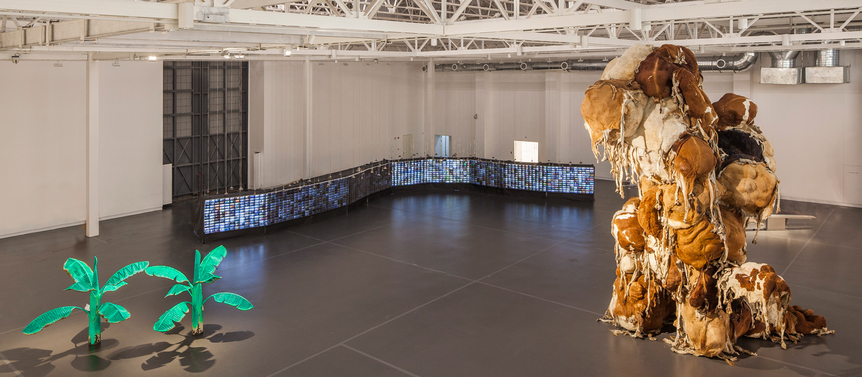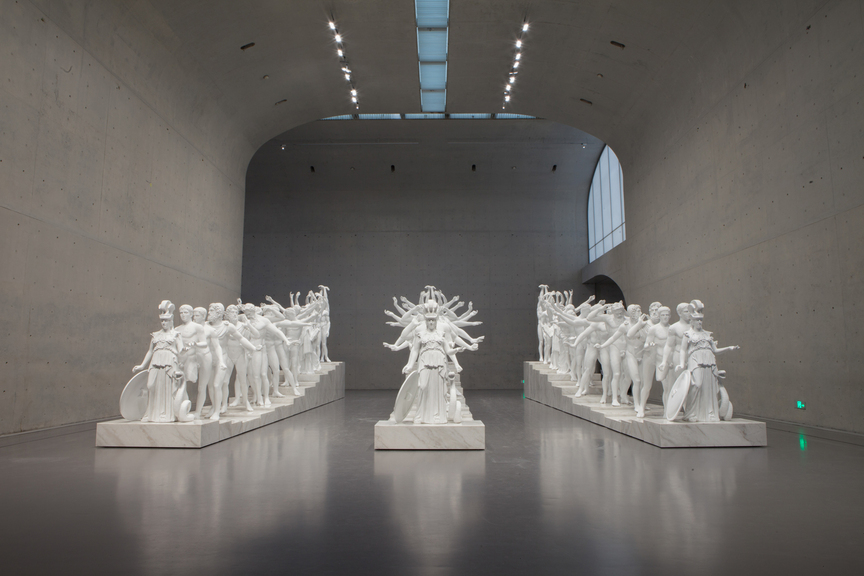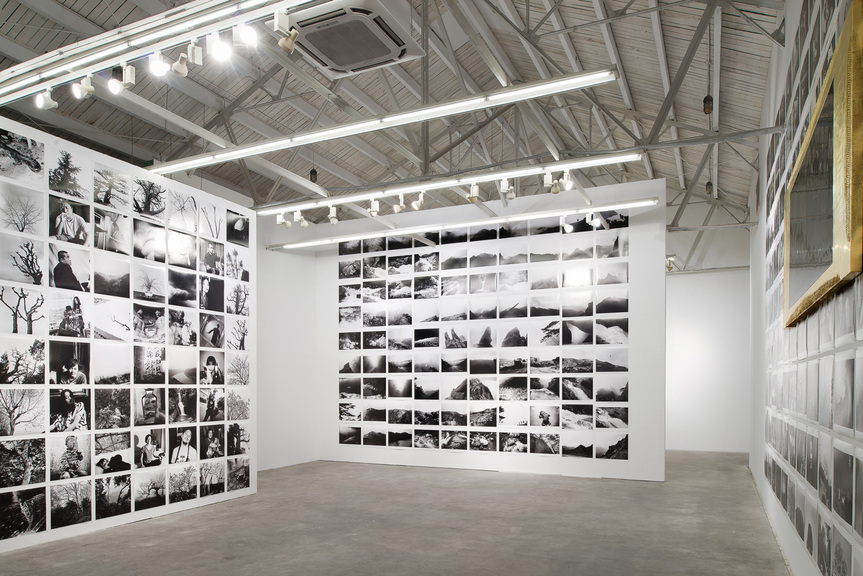
R
E
V N
E
X
T
As winter draws to a close and the first warm Spring breeze reaches the West Bund Riverside, two of Shanghai’s young museums celebrate their first anniversary in the vibrant arts district, while two old favorites endeavor to reaffirm their cultural footprints. Once again, these art institutions are living proof of the populous city’s advancement (and deep pockets) when it comes to providing creative platforms for local and international contemporary art.
Paper Topographies
Entering its fifth year, Rockbund Art Museum, conveniently located near the bustling commercial area of East Nanjing Road, kicked off the exhibition season with “Tears of a Tree” (1/31–5/3), the first major museum exhibition in Asia for Los Angeles-based décollage artist Mark Bradford. A new series of eight buoy-shaped sculptures and three freshly commissioned, large-scale collages mapping the Shanghai cityscape consumed the five floors of the museum. Inspired by both modern and colonial maps discovered at a local book market, Bradford’s unique collage technique of layering and erasing collected materials explores the dynamics of an urban landscape shaped by history and visual culture. The discernible street grids and red foreground in Bradford’s Falling Horses (2014)—spanning a width of over 12 meters—highlights the density of Shanghai’s buildings and population. The artist’s use of paper, inspired by the French affichiste artists of the late 1950s, addresses issues of city development and immerses itself in Shanghai’s street culture through visible traces of urban “artifacts.”
Bradford’s atmospheric collages of urban topography captures a timeless, fantastical sphere of Shanghai, a mythological microcosmos of layered histories and curiosities that offer a charming escape from today’s ever-bustling city life.
Of Myth and Monsters
From one wondrous universe to another, the one-year-old Shanghai outpost of Chinese-Indonesian art patron Budi Tek’s Yuz Museum welcomed Spring with a sequel to its inaugural show from last year. Once again curated by Chinese art historian and professor Wu Hung, the second installment “Myth/History II: Shanghai Galaxy” (3/17–7/12) explores the imagination seen within contemporary art practices and the correlation between diverse cultures and mediums. With works drawn from Tek’s ever-growing collection, the exhibition examines Shanghai’s influence on the art practices of major local and expatriate artists.
The array of artworks on display spans from Jingdezhen-trained Liu Jianhua’s suspended porcelain sculptures, entitled Regular-Fragile (2002–03), to the video and sound installation 100 Years in 1 Minute (2010) by Shanghai-born multimedia artist Hu Jieming. While these works emphasize the ephemeral and forgotten ties between culture, history and contemporary everyday life, elsewhere in the show, apparent favorites of Wu and Tek reveal a rather appalling perspective on present cultural mythology through massive, animalistic sculptures. Provocative Shanghai-based artist Zhang Huan’s horrific human-faced leviathan made from cowskin, Know the Destiny (2013), is a towering frightful presence. Meanwhile satirical Italian mastermind Maurizio Cattelan’s giant, crouching cat skeleton, Felix (2001), draws simultaneously from ordinary, fictitious and tangible fears, touching upon an upsetting vision of the world’s future.
Leaving behind the atmospheric great hall with its awe-inspiring contemporary masterpieces, one of the most intriguing sightings within the exhibition is hidden in a nearby room, exemplifying the wide spectrum of art produced in China. Silk artist Liang Shaoji’s Nature Series No. 79-Chain: The Unbearable Lightness of Being (2003) displays cold metal chains wrapped in innumerable silkworm threads—a delicate dialogue between man and nature, which has been driven to perfection.
With a whole “Shanghai Galaxy” is crammed into the museum’s comparatively small space of 9,000-square-meter space, the art institution’s achievement in creating yet another impressive Yuz universe raises the bar for any forthcoming projects from Tek’s bottomless collection.
Serial Creations
Yet another museum on the West Bund is celebrating its first birthday. Long Museum presented the much anticipated, comprehensive solo show of the savvy Shanghai artist Xu Zhen (3/29–5/24), which encompassed both newer pieces and older works that represent his extensive practice focusing on the limitless production of contemporary culture.
A direct involvement in the forming of ideas, both in art and theory, resonated throughout Xu’s vast body of work on display, which centered on the notion of serial production and numbered editions. Comprising 57 classical sculptures arranged in three rows, European Thousand-Hand Classical Sculpture (2014) proudly greeted visitors in the museum’s entrance hall. Viewing the rows of sculptures from a frontal perspective, they were reminiscent of the thousand-armed East Asian deity Guanyin, with all of the background statues’ arms forming a nimbus of limbs around the foremost figures’ body. As part of the overall concept, almost all of the sculptures in this installation were replicated multiple times and seemed to blend together into an aesthetically dramatic cluster of European marble.
Elsewhere, an assortment of Xu’s works were arranged as a display of “starter-kits,” packed in giant padded boxes. Lined up in editions of five, the kits were presented as consumer goods ready for shipment. In the Arrogance set (2010–15), upon purchase one would receive an edition of his sculpture Eternity-Poseidon, Pigeons (2014), his painting Under Heaven (2014), a ceramic vase and a T-shirt, among other objects. Through the works’ overwhelming visual effect, Xu contemplates a general abundance of cultural and spiritual behavior within current society.
The multitalented Xu pushes for a new, unorthodox and excessive era of global art history, putting forward his urge to incorporate uninhibited creative productivity into the contemporary mindset.
Enter the Urban Jungle
Leaving the riverside for the quaint alleyways of the art neighbourhood M50 in the Putuo district, a private view on Shanghai life is presented by a retrospective entitled “Welcome to Birdhead World Again” (4/25–6/7) at ShanghArt H-Space, the Swiss-run gallery’s second platform for contemporary art. The artist collective Birdhead, comprising of long-time Shanghai-based friends Song Tao and Ji Weiyu, is one of China’s foremost alternative photographer duos. Conquering the urban jungle with an insatiable need to document all aspects of life, their amassed repertoire of analog photographs could certainly fill a myriad of museum spaces. At ShanghArt, the selection of Birdhead’s works is divided into “three yard-like spaces” named “jin,” meaning “to enter” or “progress forward” in Chinese.
The first space in the gallery presents a large collection of 370 untitled, black-and-white images arranged in a rectangular formation on the walls. The photographs shed light on common scenes in Shanghai life, combining arbitrary portraits of local people with an odd assortment of nature studies. Upon entering the next two spaces, the atmosphere of pure documentation shifts completely towards the theatrical. Single spotlights illuminate a dark room with Song and Ji’s latest work, comprising gloomy, landscape photographs. The solemn ambience of an intimate sanctuary follows one into the last space, a yard-like area, where the only artwork, a big lacquer plate announcing Birdhead’s World (2015) in traditional Chinese characters, unveils the idea behind the curious, overall display of works—a privileged glimpse of the duo’s photographic memorabilia.
Focusing on the city’s cultural development from local and international perspectives, old and new Shanghai art institutions are directing the spotlight onto what they perceive as unparalleled artistic talents. With that in mind, this might just be a groundbreaking year for exhibitions in the city, setting the benchmark for the seasons to come.






